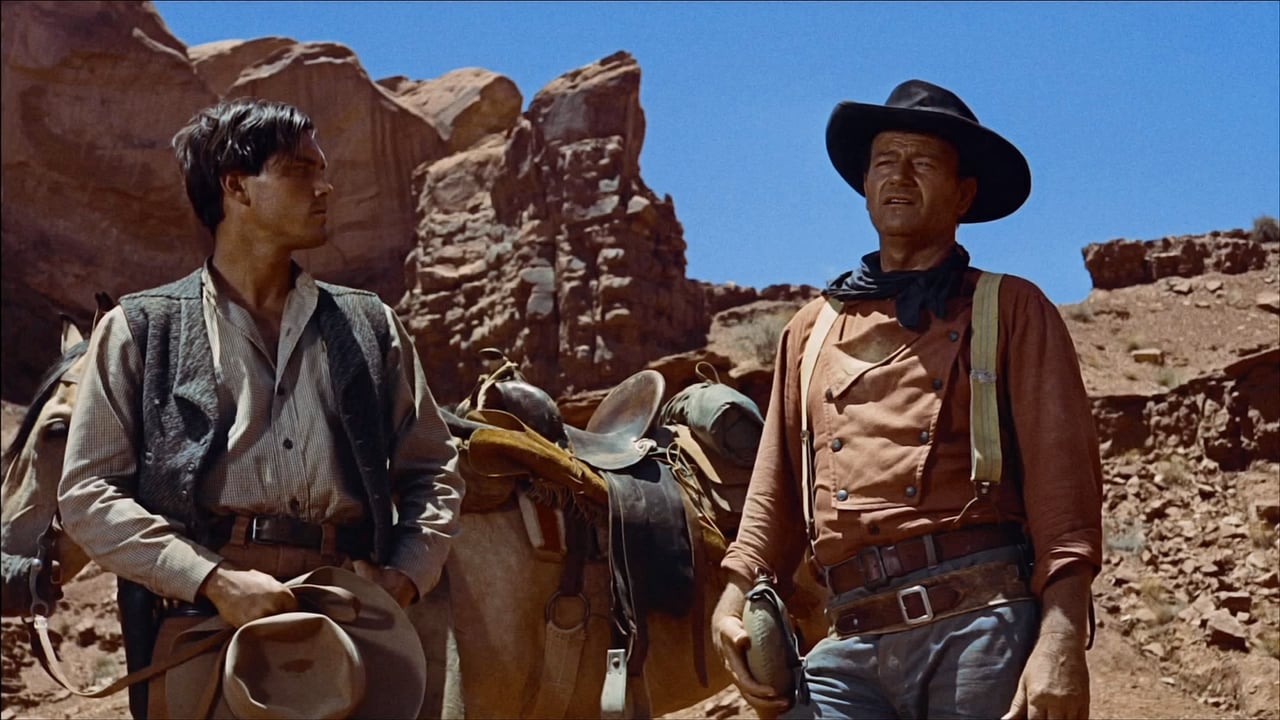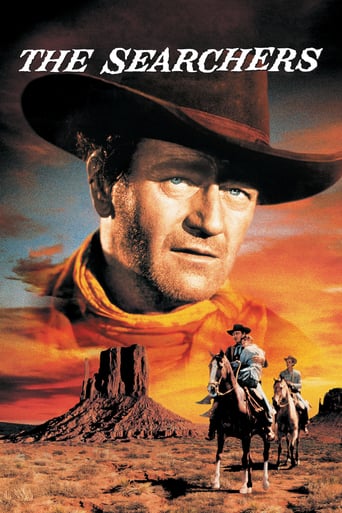

I love this film. It's not necessarily my favorite John Wayne character, but it is my favorite John Wayne movie and also my favorite John Ford film. When first watching The Searchers, it feels like it's going to be a normal John Wayne film which is normally a good to very good film where you love John Wayne (you love him in anything he's in), but usually it's not a great film with the exception of some of the greats that he has done. But as you keep watching The Searchers, you realize this isn't the norm, their is substance and greatness here. The Searchers is an epic film exploring greatness on all levels with one of the most powerful endings in movie history which is the incarnate of what John Wayne symbolizes. The Searchers is first rate supreme, a magnificent film displaying John Wayne's best qualities as an actor as well as John Ford's superb direction. A must see for any movie buff!!
... View MoreMonument Valley never looked better in VistaVision's filming process. Roger Ebert stated, "John Ford's ''The Searchers'' contains scenes of magnificence, and one of John Wayne's best performances. There are shots that are astonishingly beautiful." The only Western in history to be placed in the top 10 Sight & Sound Poll as among the greatest films of all time. AFI ranked The Searchers #12 in their all-time list and in 1989 the United States National Film Registry's first year of selecting films for preservation, chose The Searchers as one of the first 25 films to be deemed "culturally, historically or aesthetically significant." The Searchers has influenced films as diverse as Star Wars, Taxi Driver, Hardcore, Dances with Wolves, Saving Private Ryan, The Wind and the Lion and Apocalypse Now. David Lean studied The Searchers in preparation for Lawrence of Arabia and as a result movie history was made with that famous shot of the across-the-desert entrance of Sheriff Ali. Sergio Leone listed The Searchers as one of his favorite films. Much has been made of the film's racist overtones, but both sides were equally represented and based on historical fact. The basis of Ethan Edward's obsession is clearly stated when Debbie hides next to a tombstone that states the massacre of Ethan's mother at the beginning of the film. Not so obvious is John Ford's hidden subtext about Ethan's affair with his brother's wife and that Lucy or Debbie could possibly be Ethan's children. The thirst for vengeance makes total sense especially with the prospect that Debbie's been "living with a Buck." So many great scenes (the wedding scene, the letter reading scene) and lots of comic relief ("That'll be the day!"), keep the viewer's interest throughout. As far as I'm concerned, this is John Wayne's greatest acting triumph. When Ethan has to explain to Brad that Lucy was dead and he says, "What do you want me to do? Draw you a picture? Spell it out? Don't ever ask me! Long as you live, don't ever ask me more," is delivered with such harrowing conviction by Wayne, it gives me goose bumps. Then there is the scene when Ethan sees two white women who were raped by Indians and regressed to their childhood, Ethan says, "They aren't white. Not anymore." As Ethan exits we are given one of the greatest close-ups in movie history (seen over and over again in motion picture retrospectives). John Ford was sparse with camera movements and so when he employs camera movements, there is a heightened sense of drama. Ford's camera rapidly tracks in on Wayne's face to that close-up and reveals Ethan's total contempt—a chilling moment. Every shot is framed. I've never seen a movie that did this so effectively and with such beauty. It's like Frederic Remington painted each shot. Keep in mind, this is all before CGI. The cinematography is stunning. Then there is that incredible final shot, perfectly framed again with awesome cinematography and John Wayne's personal tribute to Harry Carey. I am in awe every time I watch this movie.
... View MoreThe Searchers (1956), is perhaps the darkest of western films that John Ford has ever made. His intention was to not only make a film that is dynamic in scale, but to create an example about a character who is deeply and personally conflicted with his views on culture. John Wayne named his Son after the character Ethan. The film was a bit of a challenge for the filmmakers, especially when it came to shooting the movie in the land of Utah. Ford was careful with his subject matter, but was still the master when it came down to the films art.I've seen some of John Ford's Films, one of them would have to be, "The Quiet Man". Akira Kurosawa, Orson Welles, John Milius and Steven Spielberg have considered Ford as one of the Greatest Directors of all time. Some (if most) critics were disappointed when the film did no win any awards back in 1957. The film has stood the test as being an achievement, capturing the beauty of Utah and becoming an inspiration among many filmmakers from around the globe. John Wayne was nothing without Ford's advice or direction in the film industry.I was never fond of many westerns, but this film was a huge exception. It should be considered as a study of great Cinematography and Direction. Its' subject is deep, so you've been warned.
... View MoreReleased in 1956 and directed by John Ford, "The Searchers" chronicles the story of Ethan Edwards (John Wayne) who returns from the Civil War to his brother's ranch in the Southwest; and to his brother's wife, whom he secretly loves. After the ranch is raided by Comanches, Ethan and his 1/8 Indian nephew (Jeffrey Hunter) search for the band of Indians to get his captive niece back (Natalie Wood). As time passes and the niece assimilates with the Natives it's not certain if Ethan intends on rescuing the girl or killing her.Touted as a masterpiece and one of the greatest Westerns, I've seen "The Searchers" twice now and was disappointed each time. Sure, the Monument Valley locations are breathtaking and the cast is great, but the story leaves a lot to be desired. The plot's excellent, but the way the story is told isn't interesting and so there's very little momentum. On top of this we get sequences, characters and dialogue that seem to be stabs at amusement, which (1.) aren't funny, (2.) are awkward because the main story is a serious drama/adventure in a Western context, and (3.) make some of the characters out to be dimwits (note to the writers: just because someone lives in the wilderness it doesn't automatically make them doofuses).Give me "Stagecoach" (1939), "The Horse Soldiers" (1959), "The Alamo" (1960), "North to Alaska" (1960), "True Grit" (1969), "Chisum" (1970), "The Cowboys" (1972) and "Rooster Cogburn" (1975) any day over this mediocre Western. Heck, I'll even take "The Comancheros" (1961), "El Dorado" (1966), "The War Wagon" (1967), "Rio Lobo" (1970), "The Train Robbers" (1973) and "The Shootist" (1976).The movie runs 119 minutes and was shot in Arizona, Utah and Colorado.GRADE: C-
... View More